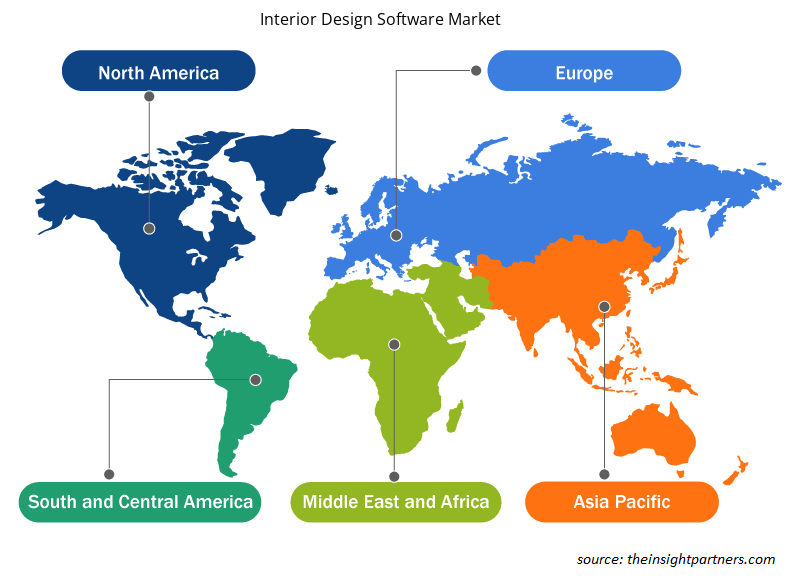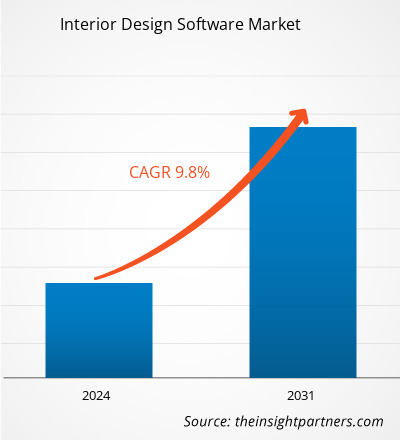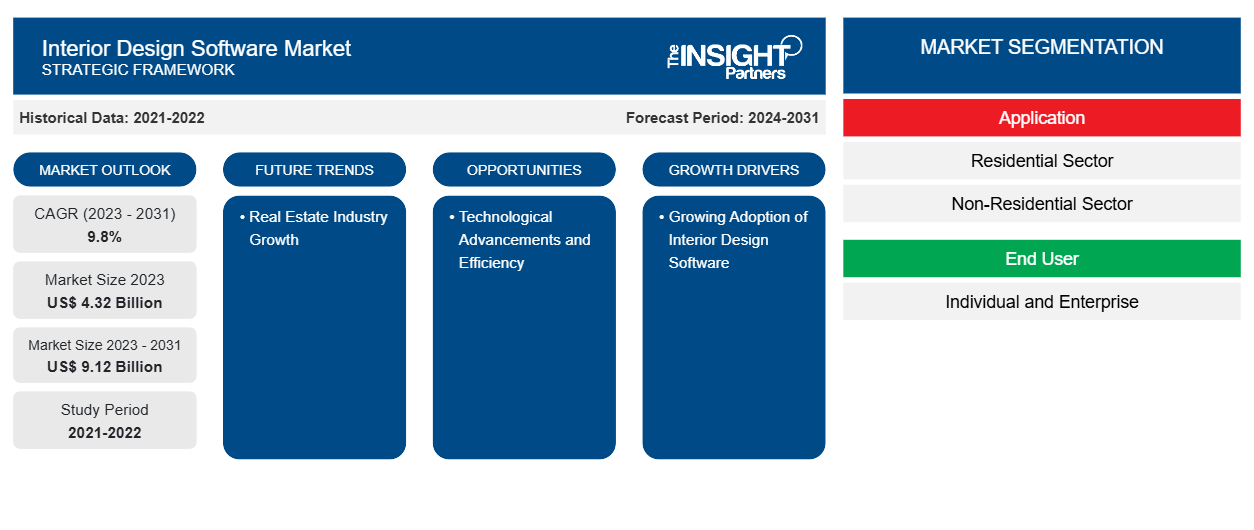Si prevede che la dimensione del mercato del software di interior design raggiungerà i 9,12 miliardi di dollari entro il 2031, rispetto ai 4,32 miliardi di dollari del 2023. Si prevede che il mercato registrerà un CAGR del 9,8% nel periodo 2023-2031. È probabile che la crescita del settore immobiliare rimanga una tendenza chiave nel mercato.
Analisi di mercato del software di interior design
La crescente domanda di maggiore produttività è uno dei principali fattori che guidano questo mercato. Inoltre, la crescente domanda di un migliore design e decorazione degli interni e il crescente utilizzo di software basati su cloud stimolano la crescita del mercato. I problemi di interoperabilità associati al software di interior design limitano la crescita di questo mercato. Inoltre, si prevede che la crescita del processo di virtualizzazione e la domanda di software di interior design, che sta crescendo a un ritmo rapido in paesi come la Cina, forniranno molteplici opportunità al mercato.
Panoramica del mercato del software di interior design
Il software di interior design consente agli architetti di effettuare una stima anticipata della qualità dell'ambiente interno. Gli architetti possono anche utilizzare questo software per identificare, tracciare e misurare qualsiasi deviazione dell'edificio progettato dai criteri richiesti. Questo software consente inoltre agli architetti di adottare misure preventive per ridurre la necessità di ristrutturazione e ricostruzione. Ha anche una raccolta completa di opzioni, come progetti per finestre , porte, letti e tavoli, che un progettista può utilizzare per creare un modello esatto della stanza.
Personalizza questo report in base alle tue esigenze
Riceverai la personalizzazione gratuita di qualsiasi report, comprese parti di questo report, o analisi a livello nazionale, pacchetto dati Excel, oltre a usufruire di grandi offerte e sconti per start-up e università
-
Scopri le principali tendenze di mercato in questo rapporto.Questo campione GRATUITO includerà analisi di dati che spaziano dalle tendenze di mercato alle stime e alle previsioni.
Driver e opportunità del mercato del software di interior design
Crescente adozione di software di interior design
Un fattore chiave di crescita per il mercato del software di interior design è il crescente utilizzo di tale software da parte di architetti, ingegneri e appaltatori. Ha contribuito in modo significativo durante le prime fasi di progettazione per la valutazione degli interni. Riduce gli errori, consente una gestione efficace del tempo e mostra eventuali differenze tra un progetto proposto e la costruzione effettiva, migliorando l'efficienza complessiva e l'accuratezza del suo lavoro impostando planimetrie, mobili e decorazioni interne in un ambiente realistico e tridimensionale.
Progressi tecnologici ed efficienza
L'improvviso aumento delle attività di costruzione globali, che si è verificato contemporaneamente all'ampia adozione di software di interior design per apportare miglioramenti nell'efficienza operativa, accelera notevolmente la crescita nel settore dei servizi di interior design. Questa tendenza è ulteriormente rafforzata dalla capacità di questo software di accelerare il processo di progettazione, risparmiare tempo e costi e offrire un'ampia raccolta di scelte di arredamento che consentono ai designer di realizzare modelli di stanze accurati e realistici. Pertanto, la crescente integrazione del software di interior design non solo semplifica le operazioni, ma contribuisce anche alla crescita assoluta del mercato.
Analisi della segmentazione del rapporto di mercato del software di interior design
I segmenti chiave che hanno contribuito alla derivazione dell'analisi di mercato del software di interior design sono le applicazioni e gli utenti finali.
- In base all'applicazione, il mercato è diviso in settore residenziale e settore non residenziale. Il segmento del settore residenziale ha detenuto una quota di mercato significativa nel 2023.
- In base agli utenti finali, il mercato è segmentato in individuale e aziendale. Il segmento aziendale ha detenuto una quota di mercato significativa nel 2023.
Analisi della quota di mercato del software di interior design per area geografica
L'ambito geografico del rapporto sul mercato del software per l'interior design è suddiviso principalmente in cinque regioni: Nord America, Asia Pacifico, Europa, Medio Oriente e Africa, Sud e Centro America.
La panoramica regionale del mercato del software di interior design rivela significative opportunità di crescita in varie regioni. Nell'Asia-Pacifico, l'aumento della popolazione e dell'urbanizzazione, in particolare nelle principali città come Tokyo, Pechino e Mumbai, ha portato a una maggiore attenzione ai settori residenziali, con iniziative come la strategia di sviluppo nazionale della Cina che mira a un'urbanizzazione sostanziale. Inoltre, si prevede che l'Asia-Pacifico registrerà il CAGR più elevato nel mercato durante il periodo di previsione, attribuito all'aumento dei piani infrastrutturali edilizi in paesi come Cina e India, nonché alla crescente urbanizzazione e all'espansione della popolazione nelle principali città come Pechino, Tokyo e Mumbai.CAGR in the market during the forecast period, attributed to increasing
Approfondimenti regionali sul mercato del software di interior design
Le tendenze regionali e i fattori che influenzano il mercato del software di interior design durante il periodo di previsione sono stati ampiamente spiegati dagli analisti di Insight Partners. Questa sezione discute anche i segmenti e la geografia del mercato del software di interior design in Nord America, Europa, Asia Pacifico, Medio Oriente e Africa e America meridionale e centrale.

- Ottieni i dati specifici regionali per il mercato del software di interior design
Ambito del rapporto di mercato del software di interior design
| Attributo del report | Dettagli |
|---|---|
| Dimensioni del mercato nel 2023 | 4,32 miliardi di dollari USA |
| Dimensioni del mercato entro il 2031 | 9,12 miliardi di dollari USA |
| CAGR globale (2023-2031) | 9,8% |
| Dati storici | 2021-2022 |
| Periodo di previsione | 2024-2031 |
| Segmenti coperti |
Per applicazione
|
| Regioni e Paesi coperti |
America del Nord
|
| Leader di mercato e profili aziendali chiave |
|
Densità dei player del mercato del software di interior design: comprendere il suo impatto sulle dinamiche aziendali
Il mercato del software di interior design sta crescendo rapidamente, spinto dalla crescente domanda degli utenti finali dovuta a fattori quali l'evoluzione delle preferenze dei consumatori, i progressi tecnologici e una maggiore consapevolezza dei vantaggi del prodotto. Con l'aumento della domanda, le aziende stanno ampliando le loro offerte, innovando per soddisfare le esigenze dei consumatori e capitalizzando sulle tendenze emergenti, il che alimenta ulteriormente la crescita del mercato.
La densità degli operatori di mercato si riferisce alla distribuzione di aziende o società che operano in un particolare mercato o settore. Indica quanti concorrenti (operatori di mercato) sono presenti in un dato spazio di mercato in relazione alle sue dimensioni o al valore di mercato totale.
Le principali aziende che operano nel mercato del software per l'interior design sono:
- Autodesk Inc.
- Architetto capo, Inc.
- Dassault Systèmes
- ECDESIGN Svezia AB
- RoomSketcher come
- Unità organizzativa Roomtodo
Disclaimer : le aziende elencate sopra non sono classificate secondo un ordine particolare.

- Ottieni una panoramica dei principali attori del mercato dei software di interior design
Notizie e sviluppi recenti sul mercato del software di interior design
Il mercato del software di interior design viene valutato raccogliendo dati qualitativi e quantitativi post-ricerca primaria e secondaria, che includono importanti pubblicazioni aziendali, dati associativi e database. Di seguito sono elencati alcuni degli sviluppi nel mercato del software di interior design:
- IKEA US ha annunciato il lancio di IKEA Interior Design Service, un nuovissimo programma che offre un interior design professionale e personalizzato a un prezzo accessibile. Consumatori e aziende avranno l'opportunità di mettersi in contatto con un esperto per progettare qualsiasi spazio con soluzioni creative.
(Fonte: Inter IKEA Systems BV, sito web aziendale, aprile 2023)
- Ingka Group, il più grande rivenditore IKEA, lancia oggi la sua nuova esperienza di progettazione digitale basata sull'intelligenza artificiale, IKEA Kreativ. La nuova esperienza intuitiva offre ai clienti il primo modo realistico e completamente integrato per progettare e visualizzare i propri spazi abitativi da computer e smartphone.
(Fonte: Inter IKEA Systems BV, sito web aziendale, luglio 2022)
Copertura e risultati del rapporto sul mercato del software di interior design
Il rapporto "Dimensioni e previsioni del mercato del software di interior design (2021-2031)" fornisce un'analisi dettagliata del mercato che copre le seguenti aree:
- Dimensioni e previsioni del mercato del software di interior design a livello globale, regionale e nazionale per tutti i segmenti di mercato chiave coperti dall'ambito
- Tendenze del mercato del software di interior design, nonché dinamiche di mercato come driver, restrizioni e opportunità chiave
- Analisi dettagliata delle cinque forze PEST/Porter e SWOT
- Analisi di mercato del software di interior design che copre le principali tendenze del mercato, il quadro globale e regionale, i principali attori, le normative e i recenti sviluppi del mercato
- Analisi del panorama industriale e della concorrenza che copre la concentrazione del mercato, l'analisi della mappa di calore, i principali attori e gli sviluppi recenti nel mercato del software di interior design
- Profili aziendali dettagliati
- Analisi storica (2 anni), anno base, previsione (7 anni) con CAGR
- Analisi PEST e SWOT
- Valore/volume delle dimensioni del mercato - Globale, Regionale, Nazionale
- Industria e panorama competitivo
- Set di dati Excel
Report recenti
Rapporti correlati
Testimonianze
Motivo dell'acquisto
- Processo decisionale informato
- Comprensione delle dinamiche di mercato
- Analisi competitiva
- Analisi dei clienti
- Previsioni di mercato
- Mitigazione del rischio
- Pianificazione strategica
- Giustificazione degli investimenti
- Identificazione dei mercati emergenti
- Miglioramento delle strategie di marketing
- Aumento dell'efficienza operativa
- Allineamento alle tendenze normative























 Ottieni un campione gratuito per - Mercato del software di interior design
Ottieni un campione gratuito per - Mercato del software di interior design